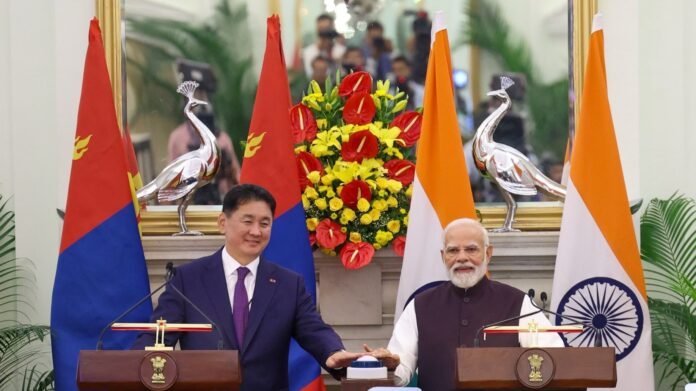Mongolian President Khurelsukh Ukhnaa’s recent visit to India has gone nearly unnoticed amid the chaos in global politics. This characterises and sums up the status of India-Mongolia relations. Mongolia is among those countries with which India takes pride in having centuries-old cultural ties, which provide a base for the two countries to develop their interactions. However, despite having a long history of solid soft power engagements, India-Mongolia ties are still in an emerging stage and yet to translate their potential into substantial and diversified engagements.
The two sides are now exploring their partnership in hard power. India considers Mongolia a vital country in its extended neighbourhood and a strategic partner to navigate the complex global geopolitical realities. Recognising the role Mongolia could play in India’s interests, Prime Minister Narendra Modi visited Ulaanbaatar in 2015, thereby becoming the first Indian prime minister to visit Mongolia. During his visit, both countries elevated their relationship to a strategic level. President Ukhnaa’s visit to India also coincided with India and Mongolia celebrating 70 years of their diplomatic ties and 10 years of strategic partnership.
Through the realm of strategic partnership, India is steadily nurturing defence cooperation with Mongolia. Since 2006, New Delhi and Ulaanbaatar have been involved in joint military exercises named Nomadic Elephant, held alternatively in India and Mongolia. The 17th edition of this drill was held in Ulaanbaatar in June this year. India also participates in the multinational military exercise Khaan Quest held in Mongolia. Khaan Quest began as a bilateral exercise between Mongolia and the United States in 2003, but was transformed into a Multinational Peacekeeping Exercise in 2006.
During President Ukhnaa’s visit, India announced the posting of a defence attache in Ulaanbaatar. Prime Minister Modi announced the start of a capacity-building programme under which India will train the border security force of Mongolia. These developments indicate both countries’ intent to deepen security cooperation
Building upon the defence ties, during President Ukhnaa’s visit, New Delhi announced the posting of a defence attaché in Ulaanbaatar. Prime Minister Modi announced the start of a capacity-building programme under which India will train the border security force of Mongolia. These are positive developments indicating the intent of both countries to deepen their security cooperation.
Engaging with Mongolia enables India to expand its outreach to East Asia. Mongolia is a crucial component of India’s Act East Policy, as well as its Connect Central Asia and Look North Policy. Like Central Asian countries, Mongolia too has the status of an extended neighbourhood in India’s foreign policy. For Mongolia, India is an important partner in its Third Neighbour Policy. Since 1994, Mongolia has been following the doctrine of Third Neighbour to develop close ties with countries other than Russia and China, which are Ulaanbaatar’s immediate and only neighbours.
However, there are certain challenges that the two sides need to address.
While Mongolia is looking to expand its diplomatic outreach through its Third Neighbour Policy and already has substantial engagements with countries such as the US, Japan and South Korea, India must do heavy lifting as Mongolia may still be perceived by the West as tilting towards Russia and China
One, the tyranny of geography has played a part in India-Mongolia relations, as is the case with India’s relations with several countries, including Central Asia and Latin America. While India and Mongolia enjoyed close contacts in ancient times, in the modern era, the reshaping and emergence of borders meant that the contact between the two civilisational states was restricted. Being a landlocked country tucked between Russia and China, Mongolia remained distant for India.
Two, in continuation of the previous point, Mongolia’s geographical location has subjected it to the geopolitical competition between bigger regional and extra-regional powers. Being sandwiched between Russia and China, Mongolia, a tiny country with a population of only three million, has always had to engage in diplomatic balancing. The balancing maintained cordial ties with Russia and China, and explored expanding engagements outside of this traditional sphere. While the Third Neighbour Policy has been the backbone of Mongolia’s engagements outside of Russia and China, tensions between the West and Russia and China make it difficult for Ulaanbaatar to maintain neutrality and focus solely on its interests.
Three, for India, engaging with Mongolia implies manoeuvring amid the tensions between the US and the West and Russia and China. India’s ties with the US are already experiencing some friction over India’s close relations with Russia. While Mongolia may be looking to expand its diplomatic outreach through the Third Neighbour Policy and already has substantial engagements with countries like the US, Japan and South Korea, India would need to do heavy-lifting as Mongolia may still be perceived by the West as tilting towards Russia and China. Besides, for India, trade and energy cooperation with Mongolia has to inevitably pass through Russia’s Vladivostok port. Again, this could present India with a diplomatic dilemma in maintaining ties with Russia and the West.
India’s strategic outlook towards East Asia, coupled with Mongolia’s need to develop strong engagements beyond Russia and China, should propel the India-Mongolia ties. Both countries should now look forward to taking their relations on an upward trajectory as they have elevated their strategic partnership
President Ukhnaa’s visit to India is a significant step in India-Mongolia relations. Apart from the tyranny of geography and geopolitical competition, a principal reason behind the underdeveloped nature of ties is fewer interactions at the highest levels of political dispensations of both sides, like between the Heads of State and the Heads of Government. Only in the past decade have the ties started gaining momentum. India’s strategic outlook towards East Asia, coupled with Mongolia’s need to develop strong engagements beyond Russia and China, should propel the India-Mongolia ties. Both countries should now look forward to taking their relations on an upward trajectory as they have elevated their strategic partnership.
–The writer is an Independent Political Analyst and Researcher based in Vadodara. Follow him on Twitter: @NiranjanMarjani. The views expressed are of the writer and do not necessarily reflect the views of Raksha Anirveda






